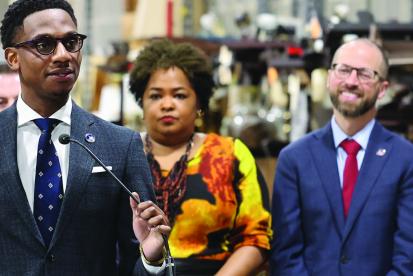Transportation Demand Management legislation introduced; RFP released for Citywide Mobility Plan
Monday, July 17, 2023 — Cleveland — Mayor Justin M. Bibb and the administration recently took significant actions to advance the mayor’s vision for a 15-minute city, where people’s basic needs can be met within a short walk, bike ride, or transit trip. The overarching goal of this work is to make Cleveland a more attractive, desirable, and safer city in which to live, work and play.
The 15-minute city framework encourages private investment along historic commercial corridors with high-frequency transit service, increases transportation choice and freedom, and promotes healthy living and sustainability — all of which improves quality of life for residents.
“Investing in multimodal corridors and transportation choice is critical to Cleveland’s success on many levels,” said Mayor Bibb. “Putting people over cars allows us to build a city that is safer, healthier, and more accessible for everyone. The time is right to prioritize and leverage equitable investments along our low carbon transportation network, especially along chronically vacant historic commercial corridors.”
Transportation Demand Management (TDM) Legislation
In partnership with City Council, legislation was introduced at the July 12 council meeting for the administration’s proposed Transportation Demand Management (TDM) policy, which supports transit-oriented development and reinvestment rooted in the core of our neighborhoods.
The city’s proposed TDM program applies to new construction and substantial renovation projects located within a quarter mile of high-frequency transit stops in the city of Cleveland. High frequency is defined in Cleveland’s context as bus or rail service that arrives at a stop every 15 minutes. TDM includes a set of policies and regulations that promote greater transportation choice and freedom. Since our region has traditionally invested heavily in automobiles, the city’s TDM policy focuses on facilitating travel by other modes such as walking, biking, and public transit.
“To be successful, our bike and transit networks must safely, conveniently, and reliably connect people to the places they want to go,” said Matt Moss, Manager of Strategic Initiatives for the City Planning Commission. “While over 200,000 jobs and nearly half of the city’s total population are located within a 5-minute walk of a high-frequency transit stop, there are also 17,000 vacant lots totaling over 2,800 acres in this footprint. This is a huge opportunity to make our neighborhoods more enjoyable places to live and work, and the city must align its rules and regulations to support investment into these areas.”
The proposed legislation will create a TDM program that swaps mandatory off-street parking requirements in the zoning code with a requirement for projects to develop a TDM plan based on the size of the project, its anticipated impact on the transportation network, and the needs of the community. The proposed legislation authorizes the City Planning Commission to adopt a menu of options that includes physical or programmatic investments — like the inclusion of privately owned public space, charging for off-street parking separately from apartment rents, adding secure bicycle and scooter parking, and providing transit passes for residents/employees — to enhance the ease and increase the use of multimodal transportation.
By replacing requirements to build parking with TDM near transit, the city will allow businesses and property owners to have more control over the amount of parking they choose to provide for their operations. This reduces the hurdles to opening small businesses, facilitates the development of more affordable housing, and helps the city meet its decarbonization and equitable development/transportation goals, particularly for the city’s young people and those who do not own a vehicle, either by choice or necessity. Overall, the TDM program will make it easier and more enjoyable to get around the city outside of a car, and less costly and complicated to bring historic storefronts and vacant lots along transit corridors into productive use.
Citywide Mobility Plan
Last week, the city also released a Request for Proposal (RFP) to select a consultant team to develop a Citywide Mobility Plan that makes it easier, safer, more convenient, and more enjoyable to move around the city outside of a car.
Per the 2022 Complete and Green Streets ordinance, Cleveland is required to adopt such a plan at least every five years. This process will meaningfully engage residents to build on recommendations from past comprehensive planning efforts, including the 2007 Bikeway Master Plan, to guide bicycle infrastructure build-out, identify needed improvements to pedestrian safety and accessibility, and propose program and policy improvements for people walking and biking. The Citywide Mobility Plan process complements a December technical assistance award from the national nonprofit mobility consultancy City Thread.
“The City of Cleveland's Mobility Plan will lay the foundation for equitable investments in making our streets safe for people of all ages and abilities, whether they are biking, walking, scooting, using public transit, or driving,” said Jacob VanSickle, Executive Director of Bike Cleveland. “This plan will be a North Star for the city and its partners, paving the way for a proactive approach to bike and pedestrian infrastructure.”
Initiatives and Programs Building the 15-Minute City
These specific steps will move us closer to being a city where everyone can access their needs and wants within a short 15-minute walk, bike, or transit trip. They also support and are themselves strengthened by parallel initiatives of the city, which are essential to the overall 15-minute city framework, helping us achieve a city that is safer, healthier, more affordable, more sustainable, and more enjoyable.
Parallel initiatives include:
- $3.5 million in the ARPA-funded Back-to-Basics program toward multimodal safety enhancements to modernize our streets, including a citywide expansion of the successful speed table pilot, modular bus stop islands that make boarding the bus faster and more efficient, and signal upgrades to make intersections safer and easier to navigate for pedestrians.
- Partnership with the Ohio Department of Transportation (ODOT) to improve pedestrian safety through the Pedestrian Safety Improvement Program.
- A $1.8 million Federal SMART grant award to prototype smart signals that can provide emergency vehicle preemption, transit prioritization, bicycle and pedestrian detection, and video-based safety analysis and close call detection.
- Continued development and implementation of the Complete and Green Streets policy to increase input and transparency and integrate multimodal and sustainable elements into upcoming roadway projects.
- The city’s shared mobility initiative, through which scooters and e-bikes are available for short term rentals.
- The city’s Form Based Code pilot, which will comprehensively update and replace the zoning code in three neighborhoods with modern land use policies and regulations.
The 15-minute city framework encompasses many of the social and economic goals of the Bibb Administration, including addressing traffic safety through Vision Zero, decarbonizing our city and responding to climate change through proximity and transportation choice, improving air quality and public health, creating conditions for more affordable and diverse housing options, legalizing many of the existing homes in our neighborhoods through a form-based code pilot program, and supporting a small business ecosystem that affords entrepreneurship opportunities for Clevelanders, among others.
While this strategy is citywide, it is necessary groundwork for specific focus areas such as the Southeast Side. Barriers to investment and opportunities are structural, and the proposed structural changes to how our city operates make it possible to realize our broad goals and jumpstart the revitalization of Cleveland’s neighborhoods.



